Understanding Central Defenders in FM23
In modern football, it’s very hard to find elite central defenders at an affordable price. Their steep increase in value makes sense when you look at the duties they have to perform and the requisite attributes to fulfil those duties. It is a role that necessitates not only extraordinary cerebral and physical abilities but also the ability to lead and organise a defensive line.
On the pitch, a team's central defender is its foundation. They provide defensive stability and offer the launchpad for attacks from behind. There are five role options available in Football Manager 2023 for players operating in central defence – Central Defender, Ball-Playing Defender, No-Nonsense Centre-Back, Libero and, the most recent addition, the Wide Centre-Back. Here, Guido Merry breaks down the five roles and explains how to identify good talents for each one in FM23.

Of the five central defensive roles available in FM23, only the Libero and Wide Centre-Back require a specific tactical configuration to be used.
In a back three, the Libero may serve as the middle defender. Alternatively, if you only wanted to operate with one central defender, you can have the Libero in that role in the middle of your defensive line.
Similarly, the Wide Centre-Back, requires a back-three setup in order to function in FM23. In this instance though, there must be three central defenders on the pitch in order to deploy a Wide Centre-Back and only the outer defenders in the three can operate with that role.
Now to dig into the specifics of each role.
The Central Defender
In most tactics, the Central Defender role is a cornerstone for most Football Manager players. Their job is a straightforward one – clear the ball away from their own goal and stop opposition forwards from getting shots on target. Players operating in this role can and will make a small contribution to the build-up play depending on your tactical choices but that is not their main responsibility.
The Central Defender role comes with three duty settings – Defend, Stopper and Cover.
On Defend duty, the Central Defender will position themselves alongside the other central defenders. In addition to breaking up attacks and defending their own penalty area, they mark their opponent. As a Stopper, the defender acts more aggressively and moves beyond the regular defensive line position to engage possible threats before they can enter the penalty area. On a Cover setting, the defender acts as the polar opposite of the Stopper; to deal with through-balls that pierce the defensive line, the defender on cover acts less aggressively and drops deeper than the other defenders in the defensive line to sweep up any balls that get through.
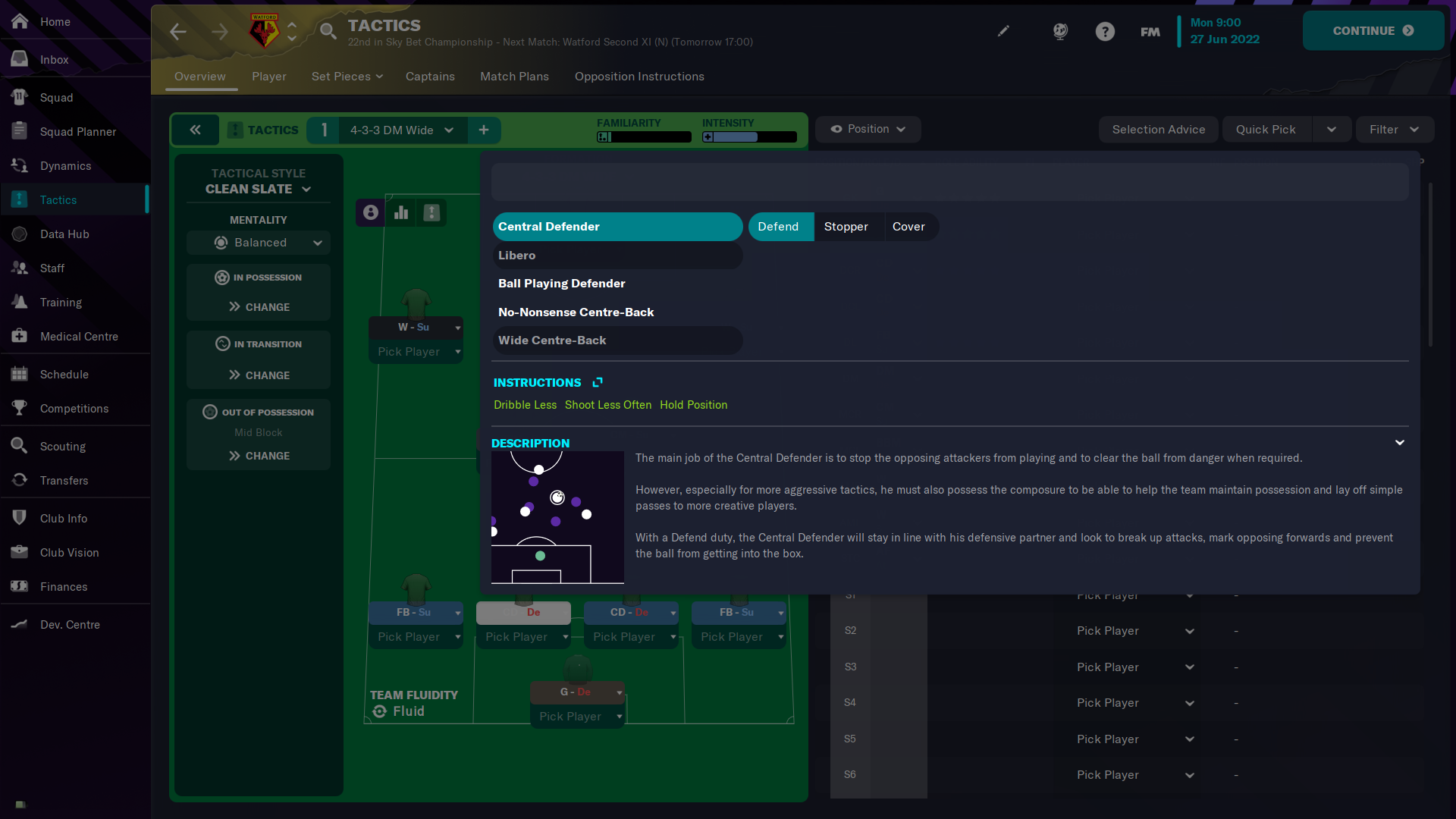
In terms of their movement, the various duties are very straightforward. Depending on the positioning of the defensive line, the stopper duty will see the defender step out of that defensive line more, whereas the cover duty will see the defender drop behind the defensive line.

The above table, which examines each of their individual instructions, shows that the hard-coded behaviour of the Central Defender doesn’t differ much between the three duties. All of them are instructed by default to Dribble Less and Shoot Less Often, with the only difference coming in the Hold Position instruction, which is only applied to the Defend duty.
The required Attributes for Central Defenders are fairly universal, regardless of duty. A player on stopper duty does not necessarily have to possess a great deal of pace, whilst a defender on cover duty is not required to be very aggressive, but as the table below shows they’re similar otherwise.
On the whole, the central defender role is a largely blank canvas and offers plenty of opportunities for customisation.
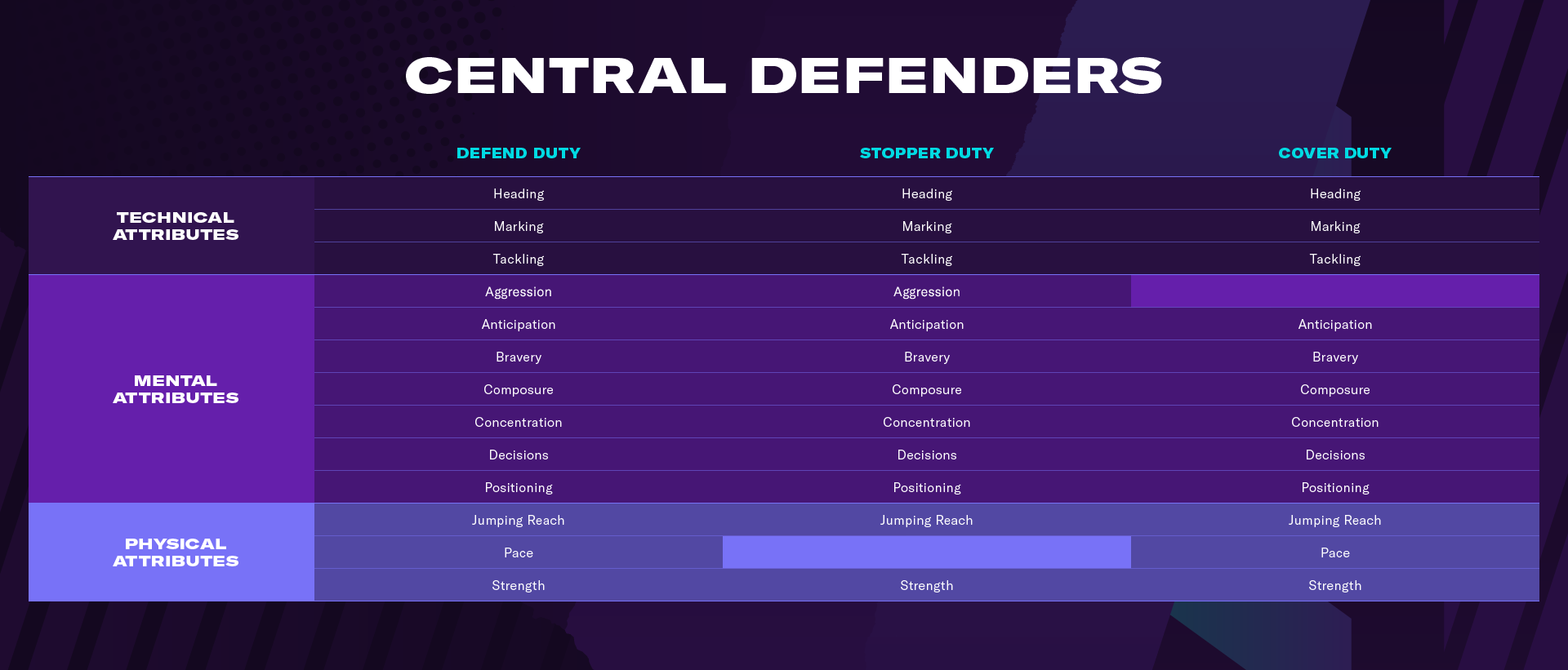
The Ball-Playing Defender
Ball-Playing Defenders engage in games much more actively than the Central Defender and in a way that sets them distinctly apart.
The primary responsibility of a Ball-Playing Defender is to clear the ball and prevent penetration of the defensive line by the opposition. However, a defender comfortable with the ball at their feet brings an added level of creativity to the game, actively participating in attacking moves and acting as a reliable passing option. Largely, Ball-Playing Defenders tend to be more imaginative and technically proficient players.
Much like the Central Defender, there are three duties available for Ball-Playing Defenders – Defend, Stopper and Cover. Again, players on a Stopper duty will step up and out of the defensive line in order to intercept opposition attacks, while those on Cover will drop deeper to sweep up passes in behind.
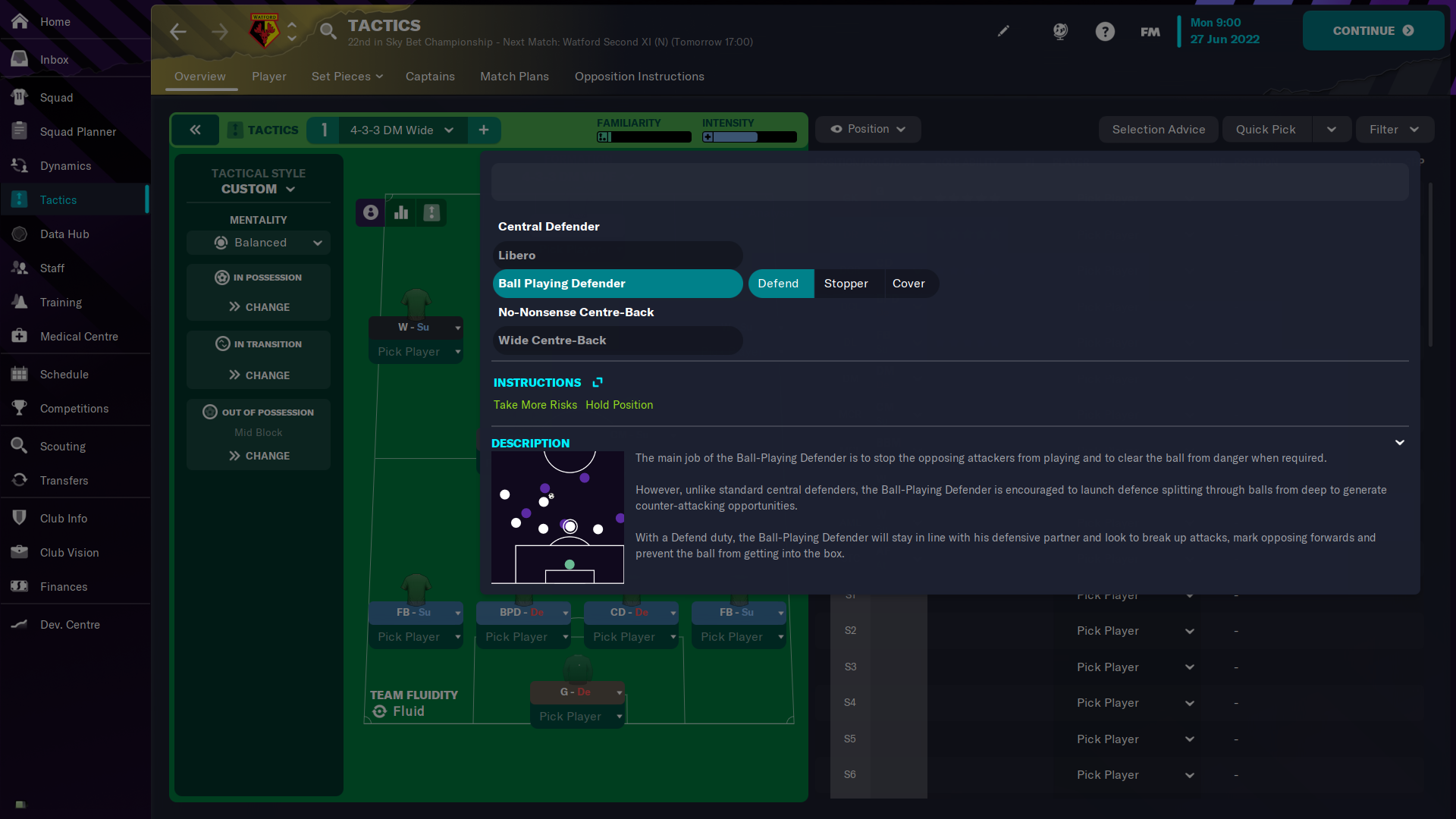
In terms of movement, it’s the same as for Central Defender. The main difference is in the passing behaviour for this player, although at times, a Ball-Playing Defender will dribble into defensive midfield if there is space. Also worth emphasising is the fact that their positioning is determined partially by the Team Instructions and is always relative to the positioning of the other defenders in the defensive line or players occupying space in defensive midfield.

The hard-coded behaviour of the Ball-Playing Defender is more defined than that of the regular Central Defender. They are allowed to dribble into midfield, which suits their ability to play through-balls. On Defend, the Ball-Playing Defender is hard-coded to hold their position. They are also instructed to take more risks, which generally means they will play more risky build-up passes from the back.
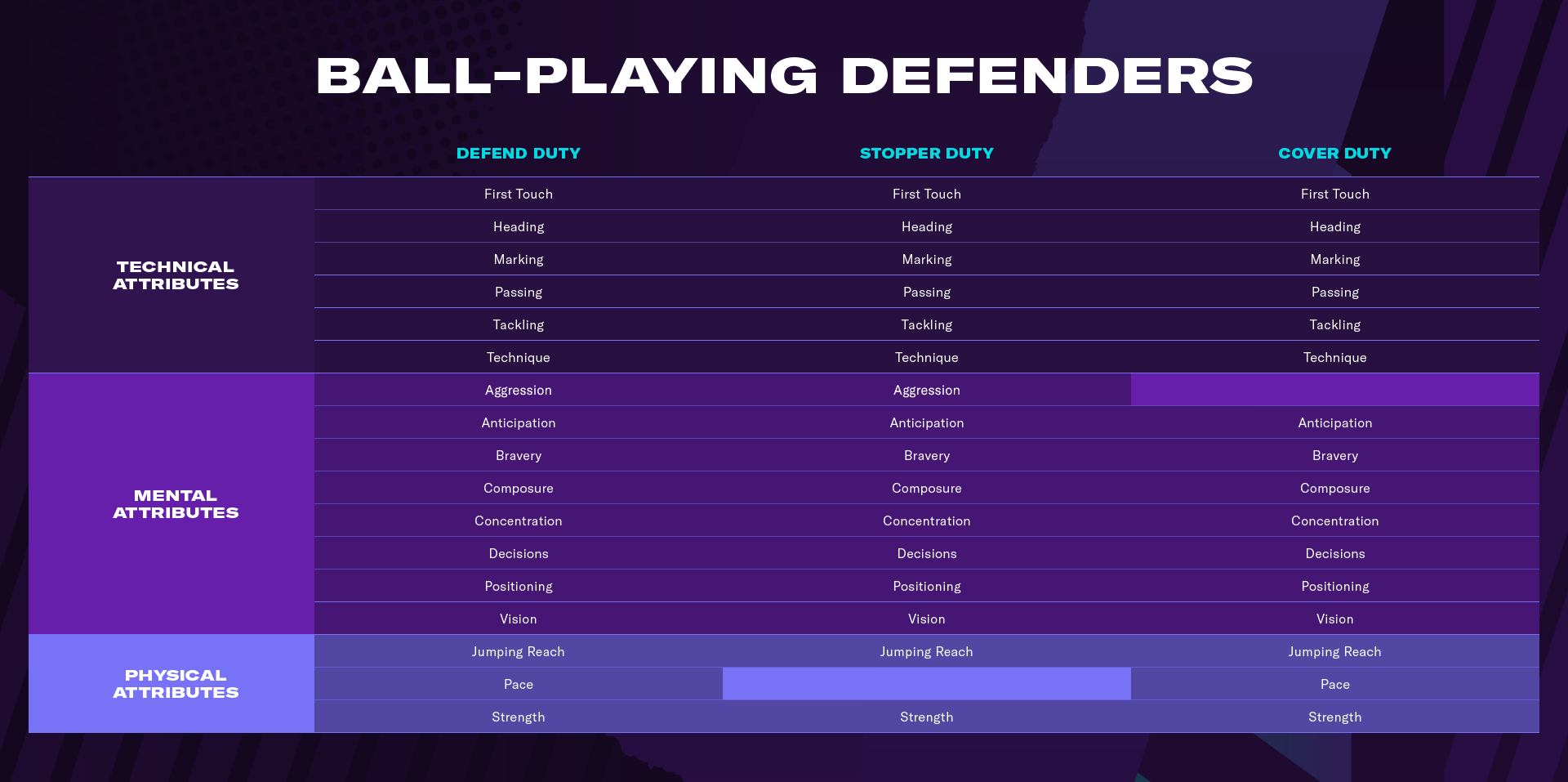
Like the instructions and movement before, the skillset for the Ball-Playing Defenders is fairly similar to that of Central Defenders. A few extra Attributes are needed to account for their skills on the ball and their expected offensive output.
The No-Nonsense Centre-Back
No-Nonsense Centre-Backs perform the same job as other central defenders but defending is more or less all they will contribute. They don’t actively avoid the ball but they will limit themselves to low-risk passing options and generally have minimal involvement when your side is in position.
Like the previous two roles, the No-Nonsense Centre-Back role is available with Defend, Support and Cover duties.

The movement is identical to that of the other central defenders so far. Stoppers move forward more, players on cover duty drop back more and on a defend setting, they will stick to the defensive line. Furthermore, and we emphasise this, positioning is determined in part by team instructions and is always relative to the positioning of other defenders in the defensive line or players occupying space in defensive midfield.

Dribbles and fancy footwork are not the domain of a No-Nonsense Centre-Back. They don't try to perform pleasing tricks because their in-game role is limited to performing their specific duties. Their hard-coded instructions mirror this no-nonsense approach to the game. They are hardcoded to dribble less, shoot less and take fewer risks, yet tackle harder, further emphasising their dedication to defensive football.
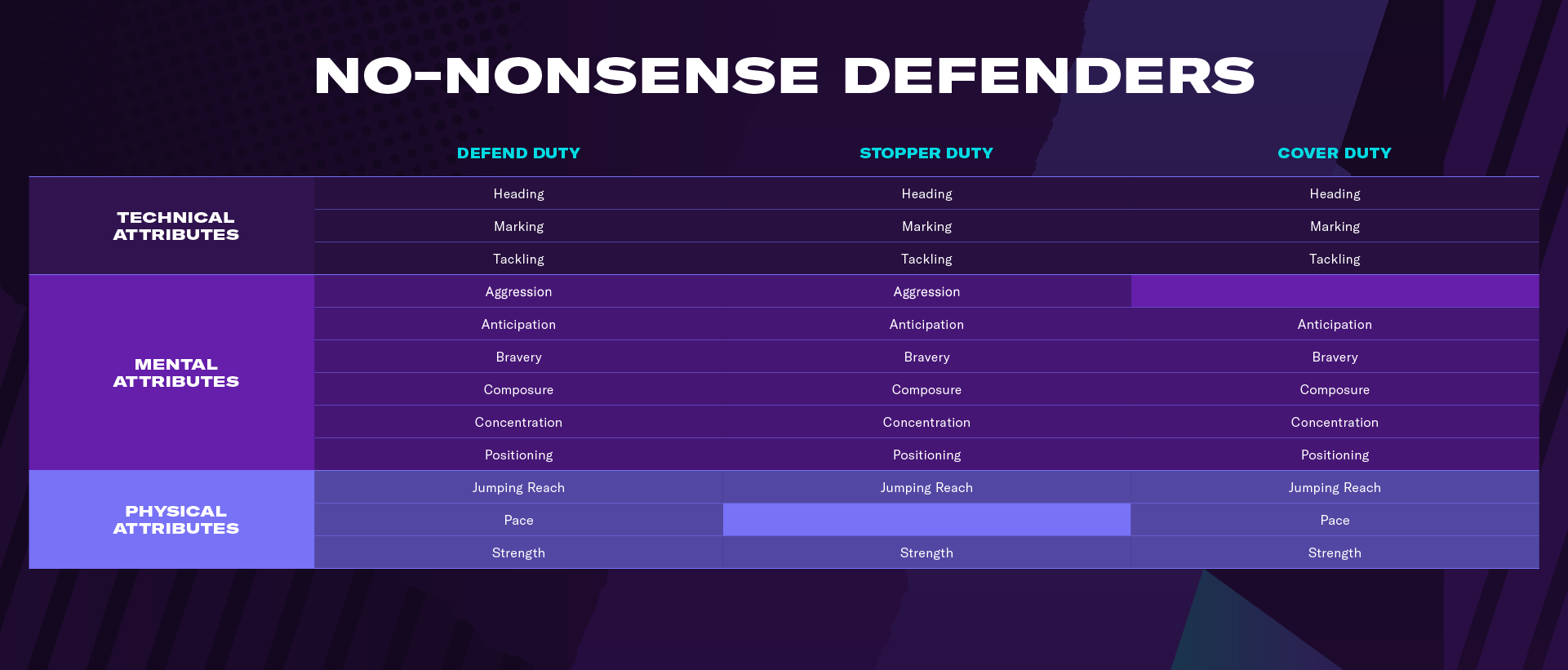
The No-Nonsense Centre-Backs have the fewest essential Attributes out of all the defenders on this list. As they restrict themselves to defending, their attributes are focused solely on the defensive areas of FM.
The Libero
As addressed earlier, the Libero is a player that’s always a member of a defensive line that consists of three defenders, with the Libero serving as the middle defender. They typically excel at stepping forward to meet the ball from a deeper position, bringing the ball out of defence, and capably and creatively distributing passes to their teammates.
The Libero is possibly best described as a hybrid of a covering defender and a Deep-Lying Playmaker due to their ability to cover space, understand the game, and play the correct pass into midfield.
Liberos come with two different duties in FM23, Support and Attack.
In terms of movement, the difference between the two duties reflects their offensive involvement. On support duty, the Libero will step into the midfield once possession is secured and look to play balls through to attacking teammates. On attack, the Libero will venture much higher up the pitch to provide a goal-scoring threat from distance as well as to play through-balls to the team’s forwards.

Having a Libero can give you more tactical flexibility – them stepping up into midfield could allow you to play an extra attacker or give one of your midfielders more encouragement to attack, as the Libero is plugging a hole in your midfield.
Whichever defensive shape you have, the other defenders will cover the Libero’s forward movements when they push up into defensive midfield (and sometimes beyond). Indeed, as long as you had suitable players in the Wing-Back positions covering the wide areas, the Libero could be your side’s deep-lying playmaker without forcing you to play a specialised defensive midfielder.

There is a reason why the Libero does not come with a Defend duty – it would be much harder for them to venture into midfield and drive your play from the back if they were expected to retain a deeper position by default. Instead, the hard-coded Player Instructions for the Libero are designed to make them shine in their playmaking, with dribbling, shooting risk tasking all encouraged.

It’s a similar story for the Attributes required for a good Libero. These are the ones that will help them create chances and move the ball as a priority, rather than blocking opponents or breaking up attacks. They will sweep up balls over the top behind the other defenders but their main aim is to be involved in the phases when your team has the ball.
Wide Centre-Backs
Like the Libero, a Wide Centre-Back is always part of a defensive line consisting of three central defenders, with the Wide Centre-Back one of the outer defenders in this line. Not solely concerned with stopping opposition attacks and clearing the ball, the Wide Centre-Back will also get involved offensively by making off-the-ball runs into more supportive, attacking positions.
The most recent tactical development on this list, the Wide Centre-Back represents a combination of a traditional Central Defender and, depending on the accompanying duty, a full-back or even a wing-back. Defensively, they will be part of that line of three but when you’re in possession, they’ll either be underlapping into half-spaces (between the pitch's centre and wing) or overlapping a wide player and providing dangerous crosses from deep.
In FM23, the Wide Centre-Back comes with three possible duties: Defend, Support and Attack. Each comes with a different expectation of movement, a product of the Wide Centre-Back role being one that dribbles far more than we’re used to seeing other central defenders do in FM.
Even on Support, the Wide Centre-Back regularly moves forward with the ball in the same way you would normally expect a full-back or wing-back to do; especially if they have the traits that encourage this behaviour (Gets Further Forward and Brings The Ball Out Of Defence). Generally, on Support or Attack duties, the Wide Centre-Back will emphasise their attacking game, and you’ll see noticeable movements from them into the opponent’s half. Their hardcoded behaviour emphasises this.
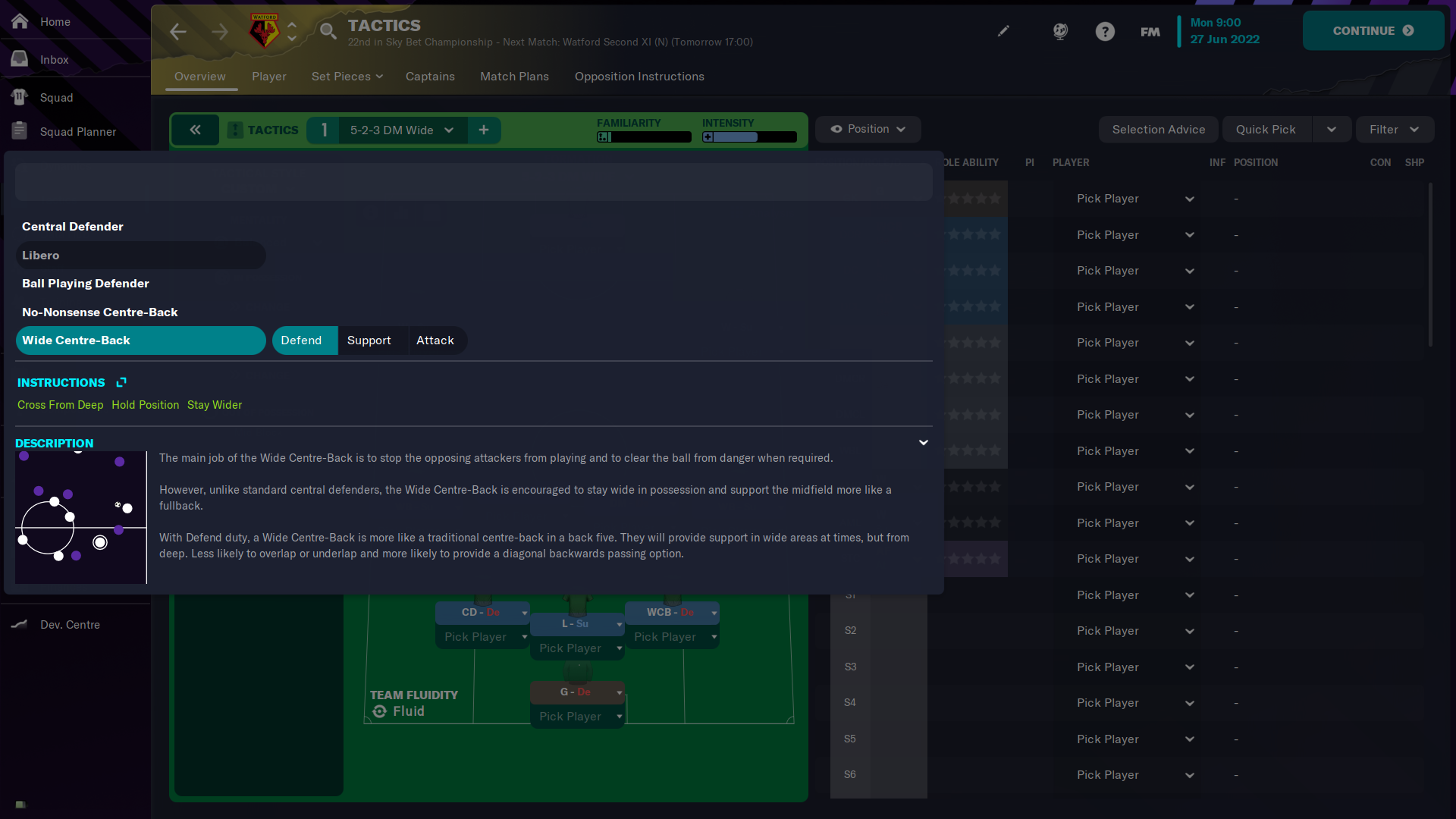
This role, and the differences produced by each duty, give you as a manger so much more room for tactical personalisation and variation. You’ll see them overlapping and underlapping, depending on the duty and the match situation, offering you an element of surprise and fluidity that the other central defender roles just don’t.
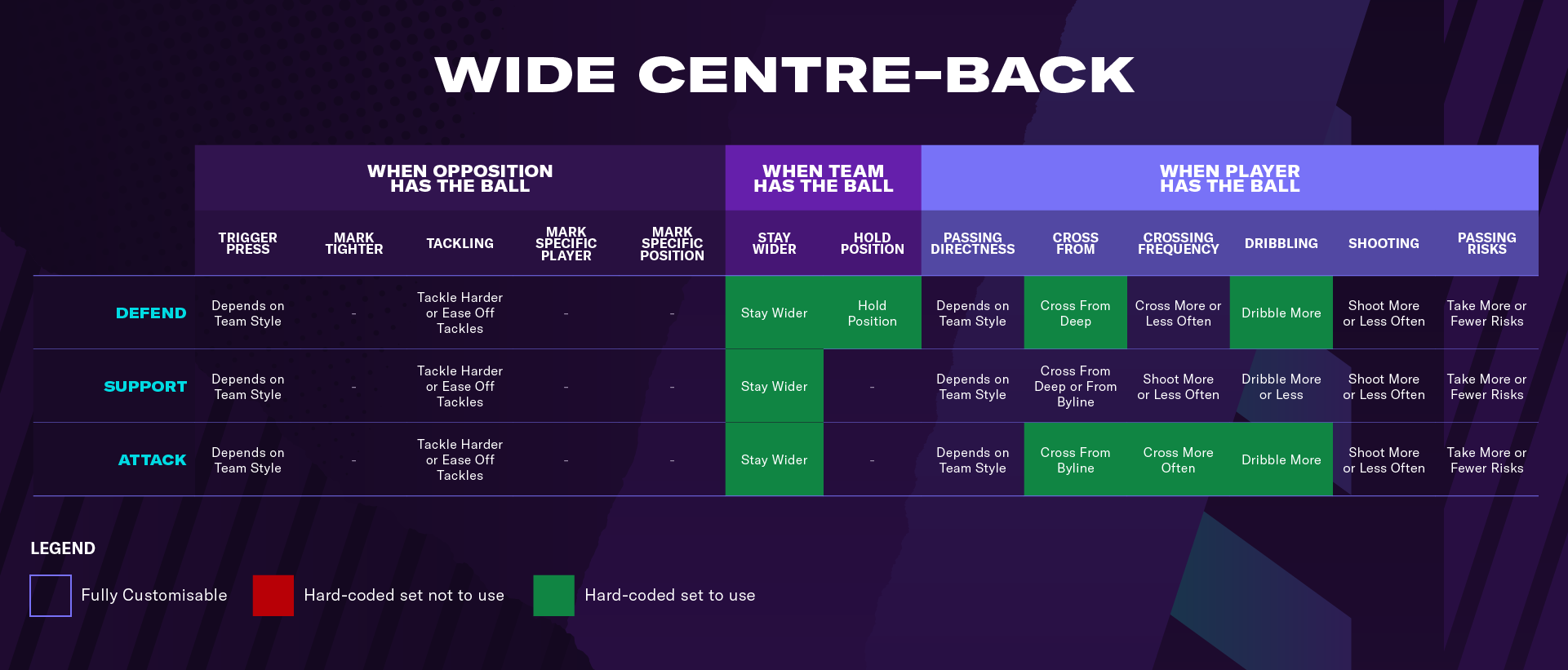
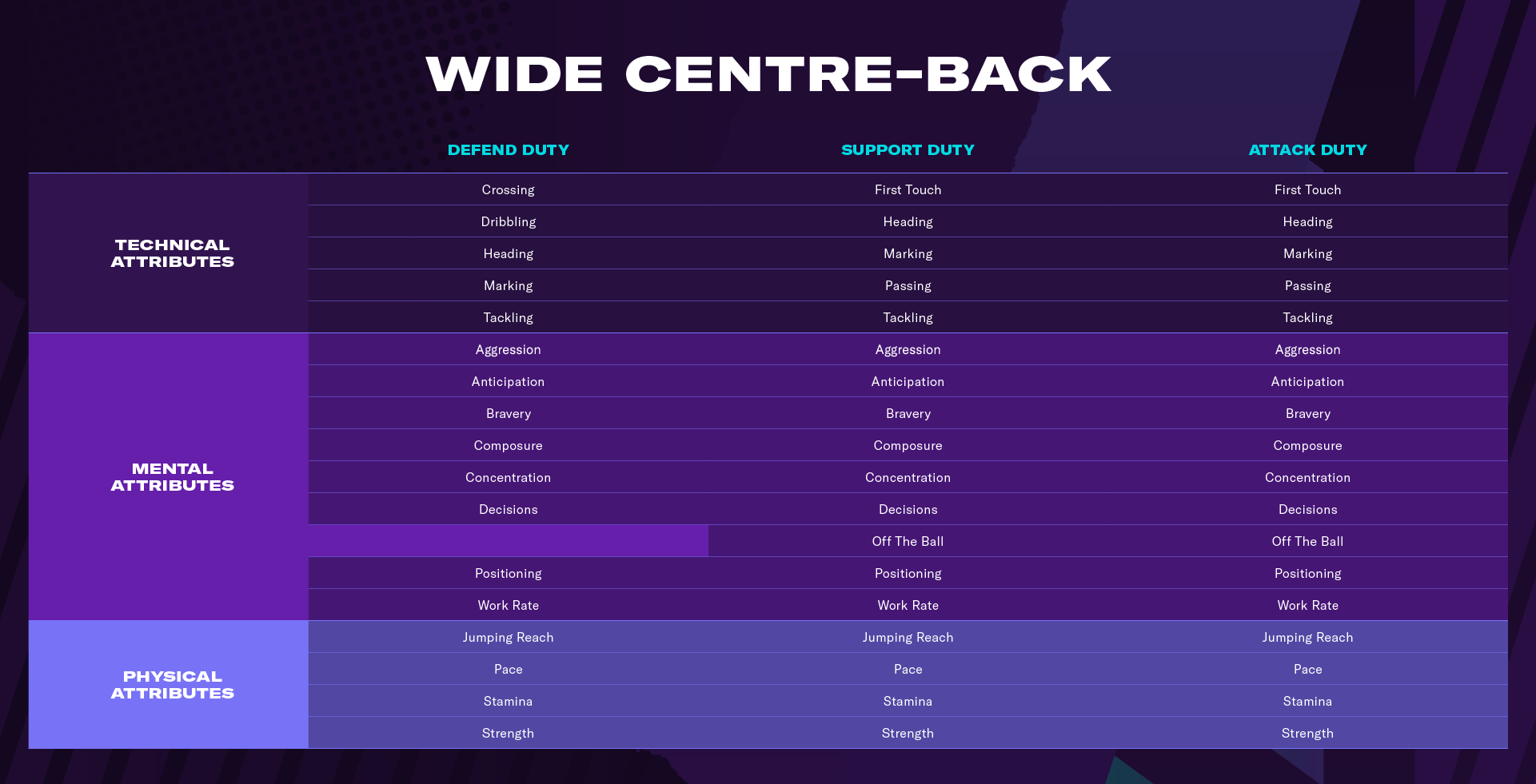
In both duties and skill sets, the Wide Centre-Back is a hybrid player. Besides the traditional Attributes required to play in a central defensive role, the Wide Centre-Back must be able to play wider and drive play forward. These additional tasks are reflected in the required Attributes; they are required to cross and dribble, for example, attributes not usually associated with central players but rather with wide players.
Key Learnings
All the above information should help you to establish a clear distinction between the five central defender roles available in FM23. To recap, here’s a summary of what distinguishes each role from the others:
- In a standard back-four, the Ball-Playing Defender is more creative than a No-Nonsense Centre-Back and will actively participate in the team’s attacks. They’ll be involved with passing moves and can help to dictate the tempo of the team from behind.
- No-Nonsense Centre-Backs tend to be more aggressive and compact than Ball-Playing Defenders, only occupying a defensive brief. They’ll only be involved in possession if it’s to play short, low-risk passes.
- The Central Defender offers a middle ground alternative between the other two, contributing to attacks on occasion while still being largely focused on defending.
- Ball-Playing Defenders are more likely to be technically gifted players with good footwork, with No-Nonsense Centre-Backs typically more straightforward players of the game.
- The Libero and Wide Centre-Back roles cannot be employed in traditional back-four defences. Instead, they have to operate in a back three, with Liberos only available centrally and Wide Centre-Backs only available in the outside slots.
- A Libero is the only defender role that lacks a defensive duty. As such, they offer the most attack-minded central defender role, alongside the Wide Centre-Back on Attack.
Happy managing,
Guido Merry
















